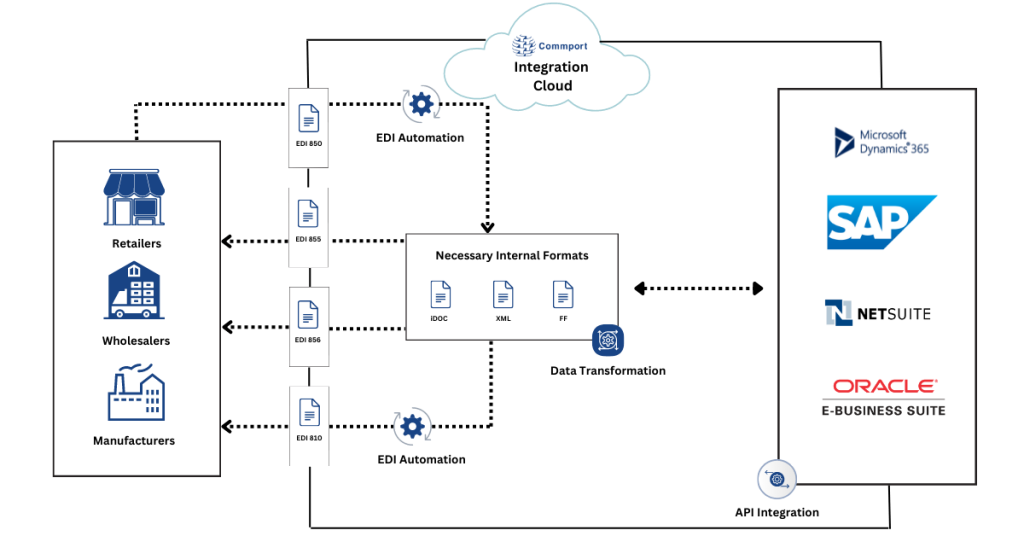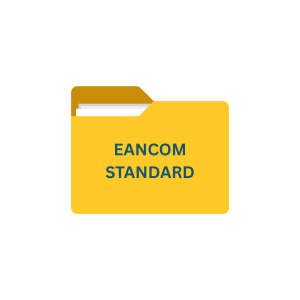Define EDI Translation
EDI translation means converting data from enterprise-specific and irregular formats into standardized and organized structures that are compliant with EDI standards. It is commonly used in business-to-business transactions to exchange documents such as purchase orders, invoices, and shipping notices. The process involves mapping data elements from one format to another, ensuring that the data is accurately transmitted and interpreted by both the sender and the receiver. EDI translation can help businesses streamline their operations and reduce errors and inefficiencies. By partnering with an experienced EDI translation provider, businesses can ensure that their electronic data is accurately and efficiently processed, improving their overall efficiency and competitiveness.
Why EDI Translation is Important?
In 2024, businesses need to maintain crucial business relationships with their trading/business partners, and adopting an integrated EDI platform will help your business ecosystem.
Most business and ERP systems don’t inherently read or create business documents using international EDI data standards such as ANSI X12 and UN/EDIFACT. As a result, there is some sort of translation or transformation needed to convert documents to and from business systems for use.
Without an EDI translation system in place, it would be extremely difficult to exchange business documents with a wide range of companies. Especially if you want to exchange data with businesses in different industries and different countries.
So, businesses need to invest in an EDI translation software/service provider that allows customers to create business documents from an in-house system and have them converted to an EDI standard format that meets trading partner requirements. The document in EDI format is then sent using the Commport VAN and communicated to the business partner who will then convert the EDI standard document into the format that meets their internal system requirements for processing.
Step-by-Step Process: How to Collect Raw Data and Translate it Into an EDI Standard Document?
1. Document preparation
First, collect and organize the data to be sent, this could be downloading data from your ERP systems, Databases, or spreadsheets in an electronic form.
2. Translation of documents into EDI standard
The next step is to input the electronic data into the translation software/system which will convert it into the standard formats using the appropriate data and segmentation elements.
The translation software outputs a data structure either in a native programming language, like the C# POCO in EDI Tools for .NET, or in XML/JSON. Some EDI translators produce records in a predefined database structure. Regardless of the exact shape of the output, the goal is to convert the cryptic contents of an EDI file to a structure that:
- Is convenient to be manipulated programmatically
- Conforms to the rules of the EDI standard
The Translation is bi-directional, e.g., it should also be able to take as input either a programming language instance, as the C# POCO in EDI Tools for .NET, or others such as XML/JSON/database records, and generate EDI files that adhere to the EDI standard.
Businesses may use an EDI VAN provider like Commport Communications for their translation requirements. In this case, the businesses just need to send the data to the EDI provider who will then handle all the translation processes and communications with your trading/business partners.
3. Connecting and transmitting EDI documents to business partners
Once the document is translated into the appropriate formats, it can be transmitted to business partners via various communications methods such as using,

Benefits of Using Commport’s Hosted EDI Translation Service
Security – In today’s digital world all data transferred between businesses must be done securely. Built on the foundation of Commport’s Tier 1 Value Added Network, Commport’s EDI translation service leverages a modern security framework to protect data integrity while ensuring compliance with trading partner EDI requirements.
Speed – For a business to grow fast, automation and scalability are very important. By increasing the speed which business can be conducted, organizations can achieve greater productivity as they grow. Commport’s EDI translation service, built directly into the Commport VAN, can help reduce the processing time by eliminating data entry, integrating business transactions, and automating document exchange between partners.
Low Costs – Manually processing documents can create errors that can potentially result in chargebacks. Integrating documents right into business systems eliminates this risk while also reducing the effort associated with processing the document.
Simplicity – Many trading partners understand that it’s important to transfer accurate and timely information between them to improve business operations and cash flow. By leveraging a translation service, businesses can focus on their core competency, and their business, and leave the technical requirements to the experts.
How does Commport EDI translation Work?
Based on the above diagram here are the exact steps Commport follows to translate and transmit your EDI documents,
Step 1 Buyer sends their business document (e.g.: Purchase order) to the Supplier, via the Commport VAN to Commport’s translation service.
Step 2 Commport translation service translates the received document (purchase order) to the supplier’s preferred format and delivers the converted document to the receiver’s mailbox.
Step 3 Supplier generates the invoice and sends the document to Commport’s Hosted EDI translation cloud for conversion to the Buyer’s invoice requirements
Step 4 Commport translates the invoice from the supplier into the buyer’s preferred document format and sends the translated document to the buyer’s order management system via the Commport VAN and the buyer’s preferred communication method.
Affordable and Top EDI Solution Provider in North America
For over 35 years, Commport Communications has been providing the most affordable and best EDI solutions in the market. By helping companies solve complex integration issues and providing complete EDI communication between business partners.
Commport EDI integration experts can manage all the EDI and B2B integration processes for you, with the flexibility and scale that you truly need. Regardless of how you move your EDI files, Commport will always make sure that you have full access to all your data in real time, including web-based dashboards, transaction reports, and automated alerts.
Improve your business process and maximize your supply chain performance with our EDI solutions. Contact us today for a free consultation and demo.
Ready to find out more about Commport EDI Translation and Mapping Services?
Need Help? Download: EDI Buyers Guide
Unlock the full potential of your supply chain with our comprehensive EDI Buyer's Guide — your first step towards seamless, efficient, and error-free transactions
Frequently Asked Questions
EDI translation refers to the process of converting electronic data interchange (EDI) messages from one format to another, enabling seamless communication between different business systems. It involves translating EDI messages from the standardized format used by one trading partner into a format that can be understood and processed by another trading partner’s systems.
EDI translation is crucial for businesses because it enables interoperability between diverse systems and facilitates efficient exchange of business documents. As companies use different EDI standards, versions, or proprietary formats, translation ensures that information can be accurately interpreted and utilized, leading to smoother business transactions, reduced errors, and improved operational efficiency.
EDI translation involves several steps:
- Parsing: The incoming EDI message is parsed into its individual segments, elements, and data values.
- Mapping: The parsed data is mapped to the corresponding fields in the destination format.
- Translation: The data is transformed and reformatted according to the target EDI standard or proprietary format.
- Validation: The translated message is validated for compliance with the target format’s rules and structure.
- Enrichment: Additional data may be added, such as identifiers or business-specific details.
- Reassembly: The translated message is reassembled into the target format.
This process ensures accurate and meaningful data exchange between trading partners.
process by handling parsing, mapping, translation, validation, and reassembly. These solutions often come with pre-built templates for common EDI formats, making it easier to configure and manage data exchanges. Automation not only re
Yes, there are two main methods of EDI translation:
External Translation: This involves using a third-party software or service to translate EDI messages between trading partners. The translation occurs outside the internal systems of the business.
Internal Translation: In this method, businesses implement an internal EDI translation solution within their own systems. This approach offers more control over the translation process and may be preferred by organizations with higher volumes of EDI transactions.
Both methods aim to achieve the same goal of seamless data exchange but offer different levels of control and integration depending on business requirements.





